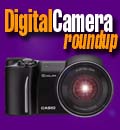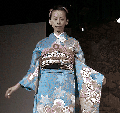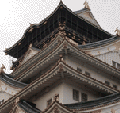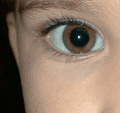At least one of the two film giants is represented in this lineup (Kodak did not respond to our request) and that comes as no surprise. Fujifilm early on realized the importance of the digital revolution and has been extremely proactive with their digital cameras and very responsive in working with the press. Fujifilm also has a nice roster of digital cameras in almost every class, and the Finepix Z1 represents their entry into the ultra-compact/ultra-thin field.
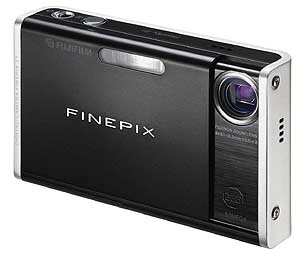 The Z1 is a small, handsome 5.1 megapixel camera that manages to differentiate itself visually with a style all of its own. The housing consists of what feels like a truly industrial-strength metal U-bracket that visually wraps around and protects the matte-black rest of the camera. It's a design solution that solicited an enthusiastic response from most people we showed it to. Personally, I felt the U-bracket was a bit too thick and heavy for a camera so small, and that it needlessly added crucial size and weight to a camera designed to be as slender and light as possible. In fact, measuring just 3.5 x 2.2 x 0.7 inches and weighing 5.1 ounces including battery and card, the F1 was a couple of design decisions away from being the slim-is-in champion.
The Z1 is a small, handsome 5.1 megapixel camera that manages to differentiate itself visually with a style all of its own. The housing consists of what feels like a truly industrial-strength metal U-bracket that visually wraps around and protects the matte-black rest of the camera. It's a design solution that solicited an enthusiastic response from most people we showed it to. Personally, I felt the U-bracket was a bit too thick and heavy for a camera so small, and that it needlessly added crucial size and weight to a camera designed to be as slender and light as possible. In fact, measuring just 3.5 x 2.2 x 0.7 inches and weighing 5.1 ounces including battery and card, the F1 was a couple of design decisions away from being the slim-is-in champion.
As is, the Finepix Z1 is a camera with much to like. Its unique body is handsome, rugged and yet small enough to easily fit into any pocket. It's both a conversation piece and a competent camera with a 5.1 megapixel Fuji Super CCD HR imager that we have found to produce excellent pictures in other Fuji cameras. Its 3X optical zoom Fujinon lens is entirely internal. A very thin slider that consists of almost the entire front of the camera turns it on and off and also acts as a lens cover. The large 2.5-inch LCD is protected by a thick acrylic shield. A sticker on the camera says it is "35x more resistant to "scratches than previous models"--which would make me reluctant to ever try one of those.
Controls are fairly minimalistic but perhaps not as logically arranged and labeled as they could be: a small round switch toggles between record and movies mode, and it sits right next to the shutter with which it can be confused. Some onscreen controls are accessed via the "Menu" button, others via the "F" Finepix Photo Mode button. Three additional buttons aren't labeled and those turned out to be indicator lamps. There are enough aspects that are slightly different that you need to take a pass through the 110-page manual which is good, but doesn't come close to the truly superb Pentax manual.
In daily use, the Finepix is a mostly pleasant companion. It fits anywhere, starts up very quickly, and the large LCD makes up for the lack of an optical viewfinder. We also like internal focus mechanisms. One problem with the Z1 is the lens placement at the extreme upper left corner where it can easily be covered by a finger.
Despite the somewhat illogical menus and controls, that is no big deal as the Z1 is a point & shooter with few extra tricks. There is an automatic mode, five "scene" modes, and a "manual" mode that really isn't--it just allows access to a few more settings.
The Finepix Z1 can shoot 640 x 480 movies with sound at 30 frames per second, but you can't zoom in or out while recording. Still images can be annotated with 30 second voice memos, but there is no separate voice recording feature. Playback volume is weak, as it is with most of the cameras here.
As just one of two digital camera manufacturers, Fuji uses the xD-Picture card format which we don't like much because cards usually cost more and are harder to find. The Z1 comes with a 16MB card, but has no internal memory.
The Finepix Z1 doesn't have a tripod mount nor any onboard I/O. Charging and cable connection to a computer are all via cradle.
We had high expectations for the Fuji's image quality and it generally did not disappoint. Pictures consistently looked good and were subjectively rated at or near the top. At higher magnification, however, sharpness and detail were sometimes lacking just a bit, but not enough to spoil the images.
We like:
- Elegant, unique design
- Among the smallest and handiest
- We love Fuji's Super CCD HR imager
Not so much:
- Lens easily obstructed by fingers
- Somewhat illogical controls and menus
- Few features
